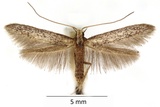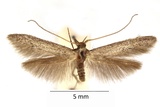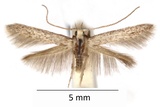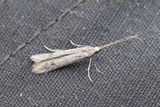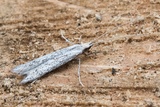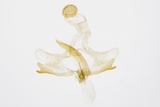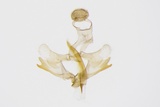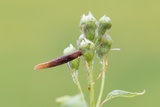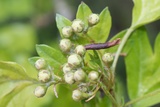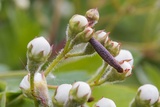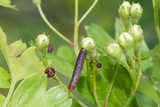Coleophora hemerobiella (Scopoli, 1763) Species
Last modified: Dec. 6, 2024, 5:13 p.m.
A fairly common species throughout Belgium.
Details
- Classification
- Family: Coleophoridae > Genus: Coleophora > Species: Coleophora hemerobiella
- Vernacular names
- Fruitboomkokermot (NL), Black-stigma case-bearer (EN), Knospenminiermotte (DE)
- First mention in Belgium
- De Fré Ch. 1858. Catalogue des Microlépidoptères de la Belgique. — Annales de la Société entomologique belge 2: 45–162. On page 143 (as C.[oleophora] Hemerobiella. Scop.). view page
- Status
-
Native
Distribution
Imago
The wingspan is 12–15 mm.
This species has whitish forewings speckled with dark grey dots and usually carries a notable blackish spot at around two-thirds of the wing length (notice the English name).
The antennae are alternately ringed blackish white till the tip.
Case
The first one and a half year the small case is pistol-shaped. Subsequently, the caterpillar builds a long straight case that measures up to 10 mm.
The mouth angle is 90°.
See also bladmineerders.be.
Bionomics
It takes the larva two years to develop. Initially, the larva lives inside a small pistol case for the first one and a half years. Only in the second spring, it builds a long straight case.
These cases reach their maximal size from May on.
Pupation takes place inside that case, attached to the upper surface of a leaf or a twig.
Occasionally, the adults come to light.
Flight periods
The adults fly in one generation a year from the end of June till well in August.
Observed on
- Host plant (species):
- Prunus avium and Prunus domestica
- Host plant (genera):
- Crataegus, Malus, Pyrus, Cotoneaster, Amelanchier, Mespilus, Prunus and Chaenomeles
The larvae are found on a whole range of Rosaceae such as Crataegus, Malus, Pyrus, Mespilus, Prunus, Sorbus, Cotoneaster, Cydonia or Chaenomeles.
